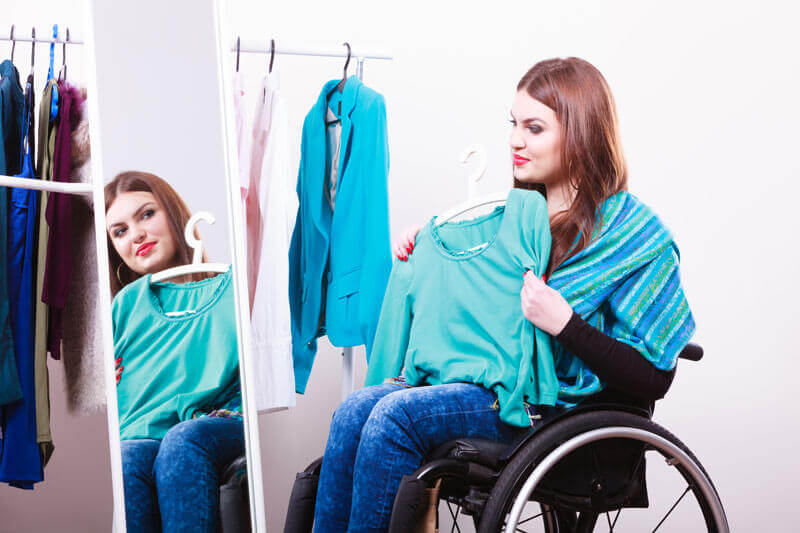What is adaptive clothing?
Adaptive clothing is designed to help those who have difficulty dressing due to disabilities as well as those with sensory issues who may find regular clothing uncomfortable or painful. Health conditions such as arthritis, stroke, and Alzheimer's, can impair someone's ability to dress themselves, most especially if the fine motor skills needed to operate buttons and zippers are reduced. Sensory processing issues can make seams and tags that others might not even notice unbearable to other people. Adaptive clothing is available for both adults and children at various companies, and even major retailers such as Target are carrying them now. Many of the more recently launched adaptive garments are designed to look just like regular clothes.

You should know that there are two main types of adaptive clothing: self-dressing (for those who are still able to dress themselves) and assisted dressing (for those who need help dressing). These types of clothing may have different features, as the adaptations that make it easier to dress yourself don't always make it easier to help someone else dress you, and vice versa.
Adaptive clothing features
Wondering exactly what adaptive clothing entails? Here are some common features that you will often find on adaptive clothing:
Hook and loop fasteners
These closures stay put all day, yet are very easy to open, close, and adjust as needed. For the most comfort, look for thinner, softer hook and loop closures that don't have hard edges that will dig into your skin.
Magnetic closures
If Velcro-like fasteners are too stiff for you, then seek out shirts and pants with magnetic closures. These closures are super easy to work. The magnets stay stuck together until you grasp the fabric panels and move them apart. Keep in mind that magnetic closures are not suitable for those who have pacemakers.
Elastic waists
Elastic waist pants are great even if you don't have a disability, and they're especially comfortable and convenient for those with limited mobility. Elastic waists do away with the need for closures altogether and also ensure that the pants can stretch or shrink to accommodate any swelling or weight fluctuations.
Open sides or backs
These shirts and pants feature overlapping fabric panels in strategic areas that offer modesty while still providing easy dressing as well as access to catheters and other medical devices. The panels may be held in place by stamps, Velcro, and other fasteners, and the open slit may descend partway or all the way down the garment.
Pull-up tabs
These stretchy straps are located on the sides of pants and make them easier to pull up. When released, the elastic goes back to its original position and lays flat against the waistband.
Higher backs on pants
Pants often pull down in the back when you sit, which can be an issue for people who use wheelchairs and others who spend most of the day in a sitting position. Adaptive pants are often designed so that the back rises higher than the front, ensuring that wearers get enough coverage.
Pull-over designs
Some shirts do away with fasteners altogether and go for a pull-over design instead. These shirts and dresses are best used by those who still have enough upper body mobility to raise their arms high and move them around. Look for shirts with wider necklines and armholes so you won't be restricted when putting it on and taking it off.
Tagless tags
Tags can cause a lot of sensory issues for people, so if they bother you, then seek out garments that print the tag directly on the garment instead of having a separate bit of fabric flapping around. Then, you'll never have to worry about cutting out a tag and dealing with a rough seam again.
Flattened seams, or seamless construction
Seams are often another source of discomfort for those with sensory issues. Look for garments that have flattened seams, or get rid of them altogether and go with seamless construction instead. You'll never have to worry about chafing again.
How adaptive clothing can help your loved one
Adaptive clothing can help your loved one continue to dress themselves for a while yet. Being able to dress themselves is very important for maintaining their sense of empowerment and independence, even when their ability to participate in other activities is compromised.
If your loved one isn't able to dress themselves, even with the help of those changes, then adaptive clothing can make the process easier on both of you. Whether it's helping a wheelchair user into pants or putting shoes on your loved one's swollen feet, adaptive clothing will reduce the hassle for both you and them.
Adaptive clothing is also more comfortable and can improve your loved one's quality of life. The reduction of uncomfortable features (such as chunky metal zippers and binding waistbands) coupled with the inclusion of comfortable ones (such as elastic waistbands and seamless construction) make for a winning combination that is sure to make them feel better.
If you've never heard of adaptive clothing before – or if you have heard of it but never bothered to check it out – it's time to change that. Check out adaptive clothing for women and men to see how it could help your loved one.
Most of the stories here on LiveQuickie.com were submitted by readers. Do you have a story to tell? We'd love to hear it. Submit your story here.